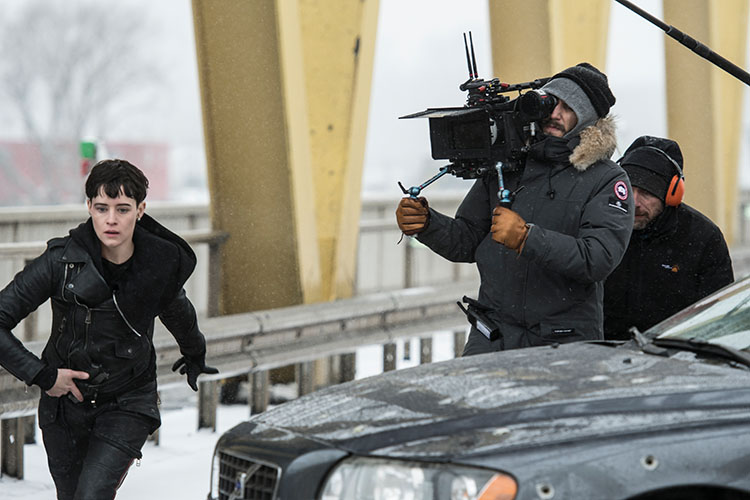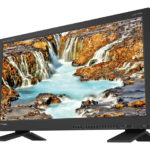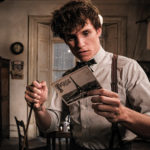
Weird Wide Web
Posted on Feb 18, 2019 by Alex Fice

Cinematographer Pedro Luque shot the new movie from the Dragon Tattoo series with a large format aesthetic, but it wasn’t all about a shallow depth-of-field
Pedro Luque almost became an architect. “I’m from Uruguay. When you’re eighteen, you have to choose what you want to do. I was leaning into architecture, but suddenly a friend of mine said he was going to start something. A film school.” To Luque, this made sense: he’d been interested in art photography since early childhood. “My dad is an architect and my mom is a psychologist. At home, there were always pencils and pens and paper, and I used to draw a lot. I started to go to comic book classes when I was thirteen or fourteen, and when I was 16 I used to go to painting classes… I was a fan of sci-fi, of literature in general, of comic books. And my dad gave me a camera, a Canon FD he had… I figured that film had a bit of literature, a bit of comic books!”
“At that time,” Pedro continues, “Uruguay didn’t have a film industry at all. We shoot a lot of commercials there now, though I haven’t lived there in five years. But in the year I started at film school, my painting mentor was asked to do the production design on a small movie.” Pedro was invited to get involved, and as a result “never stopped working and studying at the same time… by the end of film school, I think I’d shot 25 short films or something like that, almost everyone’s short. Then, when we were twenty, I met [director] Fede [Alvarez] – he was editing and I was a camera assistant shooting commercials.” Soon, Pedro and Alvarez found themselves collaborating as cinematographer and director on commercials and music videos.
A move to the USA was prompted by a successful viral short, directed by Alvarez, and the prompting of cinematographer Guillermo Navarro (of Hellboy and Pacific Rim fame) during a chance encounter. Pedro’s projects with Alvarez include 2016’s Don’t Breathe and, now, The Girl in the Spider’s Web. The film is described as a soft reboot of the Dragon Tattoo series, which was first adapted in the 2009 Swedish production directed by Niels Arden Oplev. The films, and their misfit protagonist Lisbeth Salander, are perhaps better known in the English-speaking world from David Fincher’s 2011 English-language adaptation, in which Salander is played by Rooney Mara.

Not Stieg Larsson
The Girl in the Spider’s Web is the first in the series not based on a novel by the late Stieg Larsson, instead having been adapted by the director from a book by David Lagercrantz, who continued the series after Larsson’s death in 2004. Taking place almost exclusively in Sweden, the story follows Salander (played for the first time by Claire Foy) and her journalist acquaintance Mikael Blomkvist (Sverrir Gudnason) as they pursue stolen military technology and uncover uncomfortable facts about Salander’s background; the film is tagged “discover what made her the girl.” Production took place in Berlin and Stockholm for three months, ending in early April 2018.
Pedro spent three months preparing for the shoot. “I did quite extensive research,” he says, “but with Fede it’s different… we have a friendship there, we know each other, and we have the same taste for some stuff, so I kinda know what he wants. We discussed the look a little bit, but what we wanted was for it to be expressive… human, in a way. I ended up presenting Fede with a lot of pictures and stuff, and we discussed it, but it wasn’t as extensive as in the other movies I’ve shot because we did it as we were doing it.”
Notwithstanding this somewhat empirical approach, certain decisions – particularly a colour scheme – were made early, for the benefit of production designer Eve Stewart, and Pedro particularly mentions the striking red costume choice for one prominent character, which stands out of an otherwise subdued colour palette. “It’s not that subtle. You could have dressed her in white as opposed to Lisbeth, but imagine a white dress in the snow. Also, we chose the locations very carefully – those cliffs where the final showdown happens? We wanted black rock against white snow. We wanted real places so you could feel that you’re there.”

Large format
A lot of pixels
The Girl in the Spider’s Web was shot in the Alexa 65’s Open Gate mode, which produces an image at the A3X sensor’s full 6560×3102 resolution. At just over 52 by 25.5mm, the sensor is actually slightly larger than the classic Todd-AO film aperture (around 48.5 by 20.73) and demands
lenses capable of projecting a very large image circle. The more recent Alexa LF is more compact and produces an image up to 4448 by 3096 from a more modest 36.7 by 25.5mm sensor, which is closer in size to a 35mm stills frame or the classic VistaVision film format.
As such, lenses designed for 35mm stills work can cover the LF sensor, though the push for larger formats has provoked the development of dedicated motion picture glass. One great option might soon be the Cooke Anamorphic/i Full Frame Plus lenses.
Arri’s Alexa 65 camera had been of interest to Pedro “even before starting prep, because once you put your hands on a medium format [stills] camera and you take some pictures you fall in love with it. I love the Alexa sensor, and it was just a matter of finding the right lenses for it. There’s no way of going wrong with three Alexa sensors stacked against one another.” Pedro tested the Alexa 65 against a conventional Alexa and alternatives such as Red’s Monstro sensor, using what he describes as “every lens available at Arri Berlin, and seeing the result on the big screen. It felt like the 65 was the right option. When you see thefootage it’s incredible how nice it looks, and the lenses are very nice… when you use a 50mm, you have the angle of a 25mm. Everything feels a little bit bigger.”
This bigger feeling served the filmmakers’ desire to root the characters firmly in the locations where they appear. “We needed to have a movie where the places were part of it – if it was little rooms, the old mansion, or big cliffs they had to be part of the characters. It has to do with that expression thing. If you want to express something about the characters, it’s good to make them part of their surroundings. We decide how to do, say, the house, the corridor, where to put this character. It’s not just something that happens, it’s part of the expression.
To this end, Pedro had considered shooting anamorphic, but concluded it just didn’t fit the story: “the next movie with Fede we’re going to change. I love both, and I’m shooting a pilot now in anamorphic. For stories that are more precise and clean like this one, I feel like anamorphic is distracting, so we shot it spherical.”
Still keen to avoid an excessively sharp and clinical look, Pedro chose Arri’s Prime DNA lenses. The company describes the range as “eclectic”, based on a range of carefully-selected stills lenses, rehoused to accommodate the needs of modern productions.

DNA glass
Arri is keen to make the intent of the Prime DNA lenses clear. They are not intended to have “absolute optical consistency across focal lengths” as the literature puts it, instead reaching for “character and emotion… often the lenses display unusual characteristics.” Given the popularity of anamorphic lenses, with their characteristic optical side-effects, Arri’s approach makes sense, and Prime DNA has been popular. The lenses have also seen use on Solo: A Star Wars Story, Ant-Man and the Wasp, Breathe and Bohemian Rhapsody, among others.
“We used the 55mm a lot,” Pedro recalls. “There was an 80mm that had a beautiful quality to it, and it was the fastest lens of them all. Then we had a 25mm that was great – you could put that camera wherever you wanted, and you would see a lot without being overly wide angle. The lenses we didn’t use that much were the longer lenses, but… we had some scenes with them.” Pedro also used the 120mm lens from Arri’s Prime 65 set, which he describes as “a little bit sharp – we had to use a softening filter, but it was a very useful lens, a workhorse lens.”
Camera assistants the world over are slowly coming to terms with the fact that large sensors yield shallower depth-of-field for the same field of view, all else being equal. Pedro himself is not always a fan of very shallow depth-of-field: “Sometimes I don’t want a wide shot with a shallow depth-of-field. It makes no sense – things are soft, but not soft enough. And again, with a long lens, it makes no sense unless it’s a dream.”
The reduced depth-of-field of the larger format is somewhat offset by the fact that a lens designed to cover a larger sensor will tend to be slower, unless it’s also much physically larger. “Most of the lenses are f/2.8, so if you compare them to, say, a Master Prime that’s f/1.3, it’s kind of the same depth-of-field… so it wasn’t that much of a drag. Yes, you needed more light because the reality is that the camera is ISO 800 and the lens was f/2.8, and a lot of the things we’re used to doing, when we light with one candle and an LED, we couldn’t do.”
Often, though, this wasn’t a big problem. “A lot of stuff we did on stage,” Pedro continues, “where it didn’t matter if you needed a bigger or smaller light, because we had what we needed. When you were outside in the street and there was no control over the street lights and stuff like that, sometimes without any shame we just jumped to the normal Alexa, the mini. Get me the Master Primes! I’m not afraid of mixing cameras.” Pedro estimates that up to 15% of the film was photographed on the Alexa Mini, with Master or Ultra Primes particularly for shots involving drones where the much bulkier Alexa 65 would have been difficult to handle. Establishing shots of the city, which would make good use of the high resolution, were photographed with the Alexa 65 from a helicopter.
“It’s counterintuitive,” Pedro concludes. “What I felt with the 65 was that it’s better to use it in small houses and locations because you have a better wide lens without distortion. If you need a 12mm on the normal [Alexa] it looks really weird. It’s beautiful if you know how to use it, but if you’re in some other kind of place it’s difficult to use a 12mm. But the 25mm on the Alexa 65… it’s a very wide lens, though it’s not round, it’s not like you’re looking through the eyepiece in a door. When you’re in a small space it looks great.”

Workflow
The film was shot in the Alexa 65’s open gate mode, producing a 6.5K raw file that gave digital imaging technician Rodrigo Gomez a lot of data to handle. Pedro used Arri Berlin’s dailies service, which he describes as “flawless, and we provided a lot of material.” Shooting for a 2.39:1 finish meant that most of the spare resolution was at the top and bottom of the frame, rather than at the sides. “There was a little bit of reframing… most of all top and bottom because the image didn’t have much to the sides.”
EFilm’s New York facility finished the film under the supervision of colourist Mitch Paulson, whose huge credit list includes Blade Runner 2049, Skyfall and parts of the Hunger Games, Maze Runner, and X-Men franchises. “I was in New Orleans shooting,” Pedro recalls. “Fotokem in New Orleans set up a room, and they made friends with EFilm, so I was in a room in New Orleans grading before going to set because I was shooting at night. I had about eight sessions, but I know there were about twenty days of grading.”
At the time of writing, Pedro Luque was in New York shooting a pilot for Swamp Thing, based on the DC Comics character, and directed by Len Wiseman. “It’s about this comic book that was created in the seventies that I happened to cross paths with in the eighties, when I was about twelve. When they asked me to shoot the pilot, it’s very dark, and Len asked me personally, so I said ‘of course!’”. Pedro tells of a sound stage containing a swamp set under a “ceiling of Skypanels that you can change in colour and everything – it’s a big one, and it’s difficult to shoot because everything’s in the swamp – wading, or in a boat!”

Everything is related
There’s a popular idea that bigger imaging sensors provoke shallower depth-of-field, and that’s true, assuming that field of view, f-number, and camera sensitivity are the same. On a more technical level, though, things become a bit more complicated – and perhaps even create a zero-sum game as far as image quality goes, albeit with far greater creative flexibility.
For instance, as Pedro Luque found on The Girl in the Spider’s Web, lenses designed to cover larger imaging sensors tend to be slower – to have lower minimum f-numbers. That’s because an f-stop is the ratio between the focal length and the diameter of the ‘entrance pupil’ which refers to the size of the opening in the middle of the lens through which light must pass. A bigger sensor requires a bigger image and a bigger opening, increasing that ratio and yielding a slower lens.
That can be overcome by making the lens physically larger, as with the medium-format ancestors of Arri’s Prime DNA series. It can also be offset by making the camera more sensitive so that the higher f-number is more acceptable. Of course, the larger sensor might have more pixels, making individual noise artefacts smaller and less objectionable, and making higher sensitivity more usable. That larger sensor might also have larger pixels, which would be more sensitive.
So, everything is related, giving cinematographers all the options when it comes to picking the sweet spot of lens, sensor and lighting budget.








